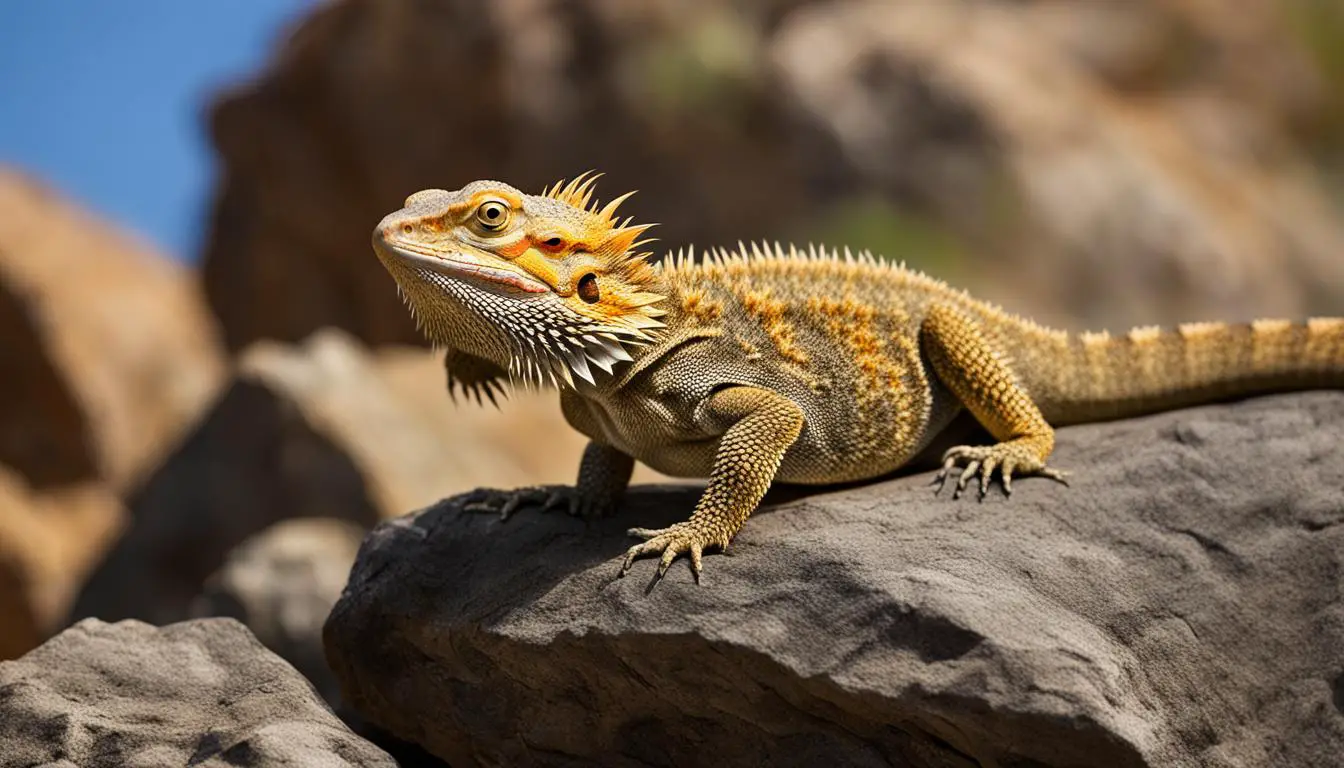Are you a reptile hobbyist looking to learn more about bearded dragons? Look no further! In this article, we will delve into the captivating world of bearded dragon species, providing you with interesting details that will make you appreciate these incredible lizards even more.
Key Takeaways:
- Bearded dragons are popular reptile pets known for their friendly demeanor.
- There are eight species of bearded dragons, with various colors and morphs developed through captive breeding.
- Bearded dragons are native to Australia and can be found in deserts, savannas, scrublands, and subtropical forests.
- Their unique features include a signature beard that changes color and spikelike projections on their necks.
- Bearded dragons communicate through head bobbing and arm waving, which have different meanings in their behaviors.
Bearded Dragon Details
The Natural Habitat of Bearded Dragons
Bearded dragons, also known as Pogona, are native to the deserts, savannas, scrublands, and subtropical forests of Australia. They are well-adapted to warm and arid environments, where they can often be found basking in the sun or seeking shelter underground to escape extreme heat. These reptiles are versatile in their habitat preferences, being mostly terrestrial but also displaying impressive climbing abilities, venturing up trees to find food or bask at higher levels.
In their natural habitat, bearded dragons exhibit fascinating behavior patterns. While predominantly land-dwelling, they can swiftly transform into expert tree climbers as the need arises. This semi-arboreal behavior further showcases their adaptability and resourcefulness in accessing food sources and suitable basking spots.
Table:
| Bearded Dragon Habitat | Characteristics |
|---|---|
| Deserts | Arid regions with sandy terrain and sparse vegetation. |
| Savannas | Grassy plains with scattered trees and shrubs. |
| Scrublands | Areas with low-growing vegetation, often dominated by shrubs. |
| Subtropical Forests | Wooded areas with moderate temperatures and higher humidity. |
These varied habitats allow bearded dragons to thrive in diverse ecosystems, showcasing their ability to adapt to different climates and terrains. Understanding their natural habitat is crucial for creating suitable environments for them in captivity, ensuring their health and well-being as pets.
Adaptability to Arid Environments
Bearded dragons’ preference for warm and arid environments is supported by their unique physiological adaptations. Their ability to regulate body temperature by basking in the sun and burrowing into the ground allows them to withstand extreme temperatures common in desert regions. Their well-developed kidneys help conserve water, enabling them to survive in environments with limited water sources.
- Desert habitats: Arid regions with sandy terrain and sparse vegetation.
- Savannas: Grassy plains with scattered trees and shrubs.
- Scrublands: Areas with low-growing vegetation, often dominated by shrubs.
- Subtropical forests: Wooded areas with moderate temperatures and higher humidity.
Bearded dragons have evolved to thrive in a wide range of habitats, showcasing their adaptability and resilience in different environments. From the arid deserts to the lush subtropical forests, these reptiles have found ways to make each habitat their own.
Unique Features of Bearded Dragons
Signature Beard and Color Changing
Bearded dragons have several unique features that make them stand out among other lizard species. One of these features is their signature beard, which consists of spikelike projections on their necks. This beard can change color, serving as a visual communication tool for these fascinating creatures. When a bearded dragon feels threatened or stressed, its beard will expand and darken, creating an intimidating display. In contrast, when the dragon is calm and relaxed, its beard will be similarly colored to the rest of its body. This color-changing ability adds to the bearded dragon’s charm and makes them a captivating pet to observe and interact with.
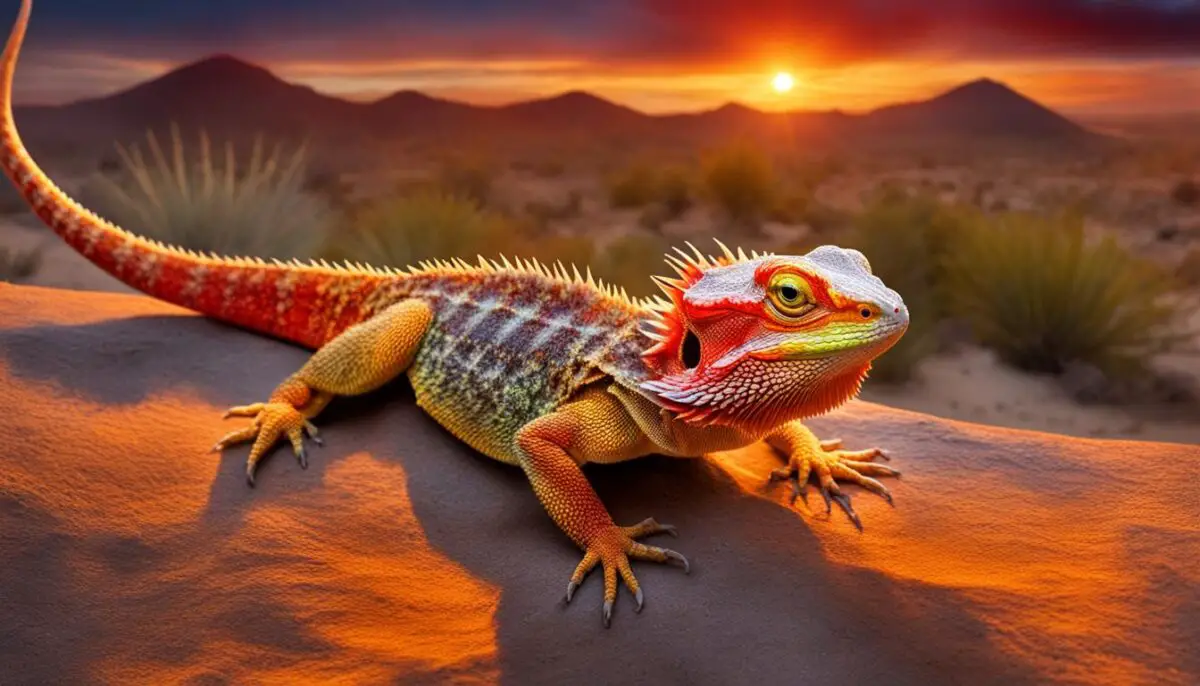
Diverse Color Morphs
In addition to their signature beards, bearded dragons also exhibit a wide range of color morphs. Through captive breeding, reptile enthusiasts have developed various color variations, from vibrant oranges and yellows to striking blues and purples. These color morphs have become highly sought after in the reptile pet trade, as each variant showcases unique and stunning patterns. The diversity of color morphs adds to the allure of keeping bearded dragons as pets, providing owners with a visually captivating reptile companion.
Adaptable Skin Coloration
Another fascinating feature of bearded dragons is their ability to change the color of their skin. While their primary coloration remains the same, they can alter the color of specific regions on their bodies. This color change serves various purposes. For instance, bearded dragons can adjust the color of their neck region for social interactions, displaying dominance or submission to other dragons. They can also change the color of their back area to regulate their body temperature, allowing them to absorb or reflect sunlight as needed. This adaptive skin coloration is a remarkable physiological adaptation that enables bearded dragons to thrive in their natural environments.
Table: Popular Bearded Dragon Color Morphs
| Morph Name | Description |
|---|---|
| Citrus | Bright orange or yellow body with vibrant patterns. |
| Translucent | Transparent skin, allowing the internal organs to be visible. |
| Leatherback | Smooth scales with a leathery appearance, giving a unique texture. |
| Hypo | Reduced pigmentation, resulting in lighter and more pastel colors. |
| Translucent Leatherback | Combines the traits of both translucent and leatherback morphs. |
These are just a few examples of the fascinating color morphs that can be seen in bearded dragons. Each morph has its own unique characteristics, adding to the overall diversity and beauty of these captivating reptiles.
Bearded Dragons as Pets
Bearded dragons have become incredibly popular as pets around the world. Their friendly nature and unique features make them a favorite among reptile enthusiasts. However, the journey of bearded dragons from their native Australia to global distribution has not been without controversy.
“Bearded dragons were smuggled out of Australia between 1974 and 1990, leading to their global distribution,” says reptile expert Dr. Emma Thompson. “This illicit trade had a significant impact on the availability of bearded dragons as pets worldwide. Today, it is estimated that there are around 900 bearded dragons in zoos globally.”
Captive breeding has played a crucial role in the availability of bearded dragons as pets. Due to Australia’s ban on the export of its wildlife since the 1960s, captive breeders have been responsible for supplying the demand for these unique reptiles. Through careful breeding, various color morphs have been developed, adding to the appeal of bearded dragons in the pet trade.
However, it is important to note that not all countries allow the ownership of bearded dragons. For example, in Hawaii, owning a bearded dragon is illegal due to the potential threat they pose to the native ecosystem.
| Country | Legal Status |
|---|---|
| United States | Legal, except in Hawaii |
| United Kingdom | Legal, but requires a license |
| Australia | Legal, but export is prohibited |
| Canada | Legal |
When considering a bearded dragon as a pet, it is essential to research the local laws and regulations to ensure compliance. Additionally, adopting a bearded dragon from a reputable breeder or rescue organization is recommended to support responsible ownership and the welfare of these captivating creatures.
Reproduction and Breeding Behavior
Bearded dragons have fascinating reproductive behaviors that contribute to their unique characteristics. One interesting aspect is their ability to lay multiple clutches of eggs in a single breeding season. After a female mates with a male, she can store sperm in her reproductive tract and fertilize her eggs over a period of time. This means that a female can lay two clutches of 11 to 30 eggs each, even if she mates only once. It’s an efficient way for bearded dragons to maximize their offspring without the need for multiple matings.
This reproductive strategy also allows female bearded dragons to control when they fertilize their eggs. By utilizing the stored sperm, they can choose to fertilize the eggs within the same breeding period or delay fertilization until a later time. This flexibility gives them the advantage of adjusting their reproductive timing based on environmental conditions or availability of resources.
Male bearded dragons play an essential role in the reproductive process as well. They engage in courtship behaviors such as head bobbing, arm waving, and color displays to attract females. Once the male successfully mates with a female, he may not be required for subsequent clutches since the female can store his sperm for future use.
Reproduction and Breeding Behavior Table
| Aspect | Details |
|---|---|
| Egg Laying | Bearded dragons can lay multiple clutches of 11 to 30 eggs per season. |
| Sperm Storage | Females can store sperm in their reproductive tracts and fertilize eggs over time, allowing them to mate only once. |
| Timing Control | Females have the ability to fertilize eggs within the same breeding period or delay fertilization for later. |
| Male Courtship | Males display courtship behaviors such as head bobbing, arm waving, and color displays to attract females. |
This reproductive strategy in bearded dragons showcases the incredible adaptability and efficiency of their breeding behavior. By providing fascinating insights into their reproductive habits, it adds to the allure of these remarkable reptiles.
Communication and Behavior
Bearded dragons have fascinating communication and behavior patterns that make them unique and captivating pets. One of their most notable behaviors is head bobbing, which can signify dominance or submission. Male and female bearded dragons use head bobbing as a way to initiate mating and establish social hierarchy. It’s an intricate and intriguing form of non-verbal communication that allows these lizards to interact with one another.
Another fascinating behavior exhibited by bearded dragons is arm waving. Arm waving is a sign of submission to a dominant individual and is often seen when a bearded dragon encounters a larger or more dominant individual. It’s their way of showing respect and minimizing conflict. This behavior adds to the charm and anthropomorphic qualities of these reptiles, making them even more endearing to their owners.
While head bobbing and arm waving are well-documented behaviors in bearded dragons, the exact meaning and significance behind these actions are not entirely understood. They are believed to be a form of communication that helps bearded dragons establish social order and resolve conflicts. The gestures and body language displayed by these lizards provide insights into their complex social dynamics and make them truly fascinating creatures to observe and interact with.
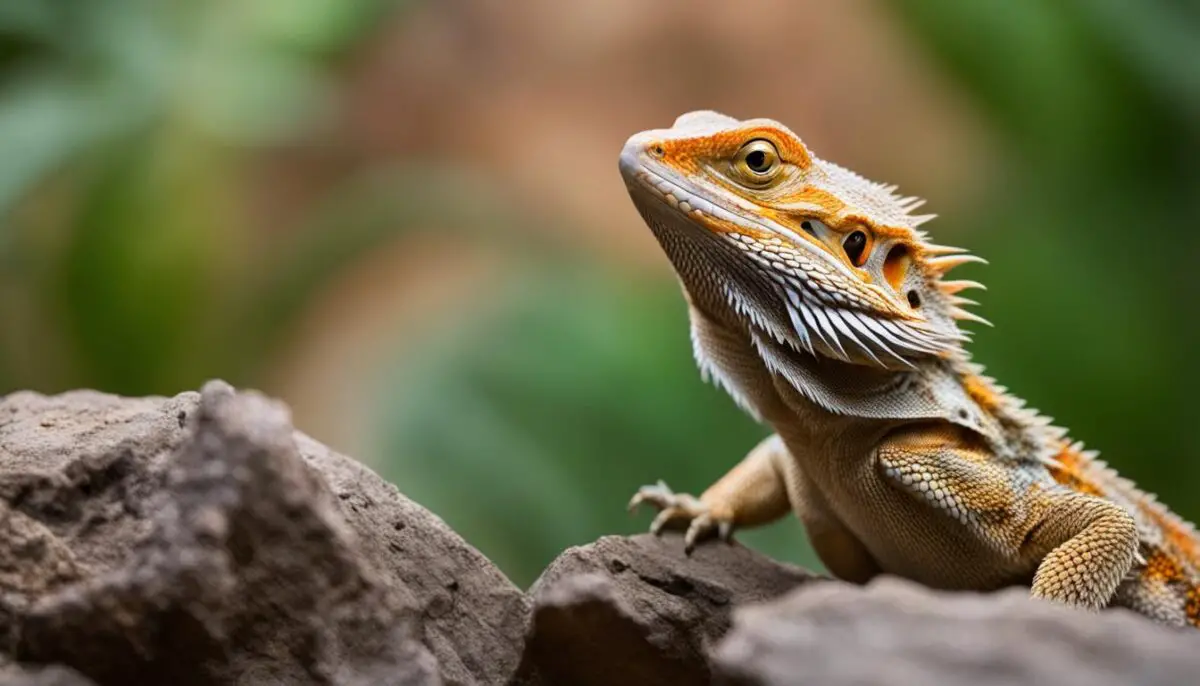
Table: Comparing Head Bobbing and Arm Waving
| Behavior | Head Bobbing | Arm Waving |
|---|---|---|
| Meaning | Can signify dominance or submission | Sign of submission to a dominant individual |
| Usage | Initiate mating, establish social hierarchy | Show respect, minimize conflict |
| Frequency | Commonly observed in both males and females | More commonly observed in encounters with larger or more dominant individuals |
| Effect | Can help resolve conflicts and establish social order | Reduces the likelihood of aggressive behavior |
Bearded Dragon Care and Husbandry
Proper care and husbandry are essential for keeping a bearded dragon as a pet. These unique reptiles require a suitable habitat, a balanced diet, regular veterinary check-ups, and proper handling and socialization.
Habitat Setup
Creating a suitable habitat for your bearded dragon is crucial for their health and well-being. Start with a spacious enclosure that mimics their natural habitat. Provide a sturdy tank with adequate space for them to move around, climb, and bask. A 40-gallon tank is recommended for adult bearded dragons.
The habitat should have a warm and arid environment with proper lighting and heating. Use a full spectrum UVB light to provide essential UV rays for their calcium metabolism. Place a basking light at one end of the tank to create a temperature gradient, allowing them to regulate their body temperature.
Add a substrate such as reptile carpet or ceramic tiles for easy cleaning and to prevent the risk of impaction from ingesting loose particles. Include hiding spots, branches, and rocks for climbing and basking. A shallow water dish should be provided for drinking and soaking, but bearded dragons generally do not require a large water source as they obtain most of their hydration from their food.
Pet Care
Bearded dragons are omnivorous and require a balanced diet. Their diet should consist of a variety of insects, such as crickets and mealworms, as well as leafy greens, vegetables, and fruits. Offer a combination of live and fresh food, ensuring that the insects are gut-loaded and dusted with calcium and vitamin supplements before feeding to provide proper nutrition.
Regular veterinary check-ups are important to monitor the overall health and detect any potential issues. A reptile veterinarian can provide guidance on diet, habitat maintenance, and address any health concerns. It’s important to maintain proper hygiene when handling your bearded dragon to prevent the spread of bacteria or parasites. Wash your hands thoroughly before and after handling them, and ensure that their habitat is cleaned regularly to prevent the buildup of waste and bacteria.
Summary
Proper care and husbandry are essential for keeping a bearded dragon as a pet. Create a suitable habitat with adequate space, lighting, and heating. Feed them a variety of insects, leafy greens, vegetables, and fruits. Regular veterinary check-ups and proper hygiene are crucial for their health and well-being.
By providing the right care and environment, you can ensure that your bearded dragon thrives and lives a healthy, happy life as your beloved pet companion.
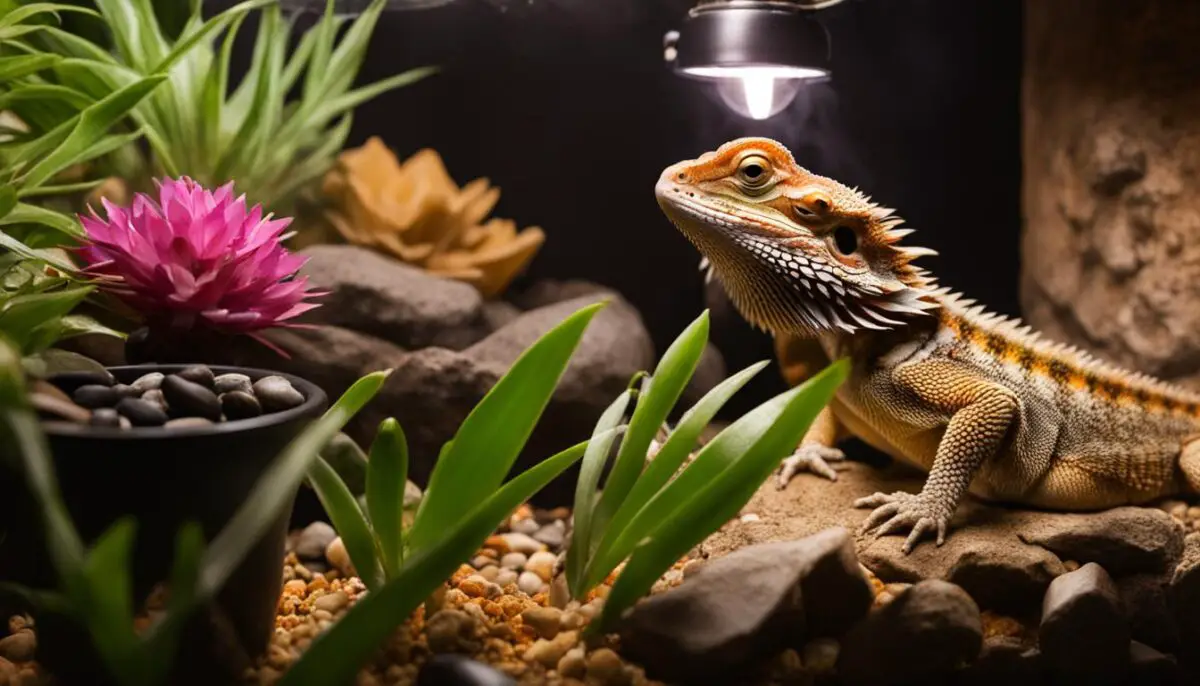
Bearded Dragon Lifespan and Health Risks
Bearded dragons are fascinating pets that bring joy and companionship to their owners. Understanding their lifespan and potential health risks is essential to providing them with the best care possible. On average, bearded dragons can live between 7 to 15 years in captivity, but their lifespan can be influenced by several factors.
One of the key factors is diet. It’s crucial to provide a balanced diet of insects, vegetables, and fruits to ensure their nutritional needs are met. A well-rounded diet can contribute to their overall health and longevity. Additionally, maintaining a suitable habitat with appropriate lighting, heating, and humidity levels is important for their well-being.
While bearded dragons are generally considered a safe pet, it’s important to be aware of potential health risks. Like many reptiles, they can carry salmonella germs in their digestive tracts. It’s essential to practice good hygiene and proper handling techniques to minimize the risk of infection. Washing hands thoroughly after handling a bearded dragon or cleaning its habitat is crucial.
“Proper hygiene and handling practices should be followed to minimize the risk of salmonella infection.”
Regular veterinary check-ups are also recommended to monitor their health and address any potential issues. A veterinarian experienced in reptile care can provide guidance on maintaining their well-being and detecting any health concerns early.
| Health Risks: | Preventive Measures: |
|---|---|
| Salmonella infection | Wash hands thoroughly after handling |
| Metabolic bone disease | Provide proper lighting and calcium supplementation |
| Respiratory infections | Maintain a clean and well-ventilated habitat |
By providing proper care, nutrition, and regular veterinary attention, you can help ensure a long and healthy life for your beloved bearded dragon.
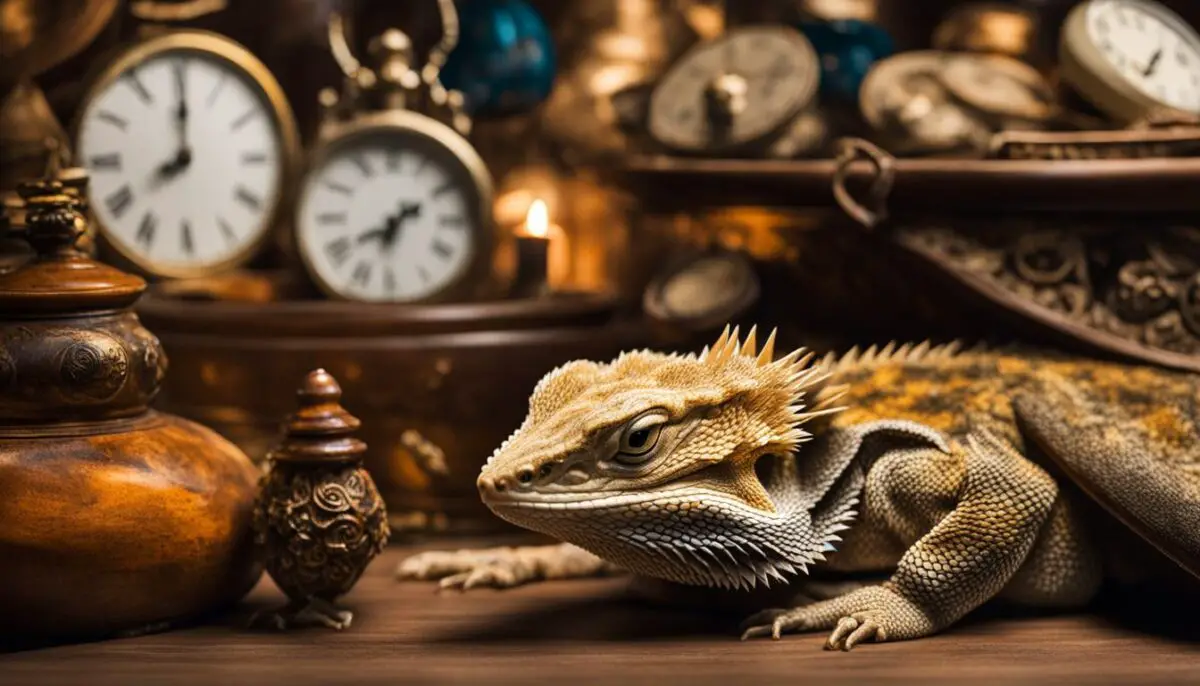
Brumation and Sleeping Habits
Bearded dragons, like many reptiles, have fascinating behaviors and unique sleeping habits. One notable behavior is brumation, a hibernation-like period that occurs in response to changing light and temperature conditions, usually in the fall or winter. During brumation, their activity level decreases, and they may stop eating for a few weeks to a few months.
As for their sleeping positions, bearded dragons exhibit various postures both in captivity and the wild. It is common to see them propped up against the glass walls or ornaments in their tanks, sleeping upright. However, this position should not cause any concern as it is a natural behavior for them.
It is important to provide a suitable sleeping environment for bearded dragons during brumation. The tank should be kept slightly cooler, replicating the natural temperature drop in their native habitats. Additionally, they should have a comfortable and secure spot to curl up and rest, such as a cozy hideout or a soft substrate. Providing a natural sleeping environment will help ensure their well-being and support their natural sleep patterns.
Bearded dragons’ ability to go through brumation and their unique sleeping positions are just a few of the many fascinating aspects of their behavior. Understanding and accommodating these behaviors in captivity is essential for their overall health and happiness as beloved pets.
Interesting Facts About Bearded Dragons
Bearded dragons are fascinating reptiles with unique characteristics that make them stand out in the world of lizards. Here are some interesting facts about these captivating creatures:
Fact 1: Varied Colors and Patterns
One of the most striking features of bearded dragons is their diverse range of colors and patterns. These reptiles come in a variety of shades, including orange, yellow, brown, and even black. Some have intricate patterns and markings on their scales, making each individual dragon unique.
Fact 2: Impressive Size Difference
Male bearded dragons are generally larger than females. Adult males typically reach a length of 18 to 24 inches, while females usually grow to be about 16 to 20 inches in length. The size difference between the sexes is more pronounced when they are fully grown.
Fact 3: Omnivorous Diet
Bearded dragons have a versatile palate and are omnivorous, meaning they eat both plant matter and insects. Their diet includes leafy greens, fruits, vegetables, as well as crickets, mealworms, and other small insects. Providing a balanced and varied diet is essential for their health and well-being.
Fact 4: Unique Defensive Behavior
When threatened or stressed, bearded dragons display a unique defensive behavior. They inflate their throat and puff out their spiky beard, making themselves appear larger and more intimidating to potential predators. This display is accompanied by hissing or even a warning bite if the threat persists.
These are just a few of the captivating characteristics and behaviors of bearded dragons. Their striking appearance, diverse colors, and interesting behaviors make them a popular choice for reptile enthusiasts and pet owners alike.
Conclusion
Bearded dragons are truly remarkable creatures that have captivated the hearts of reptile enthusiasts and pet owners worldwide. With their friendly demeanor, unique features, and fascinating behaviors, these lizards make for fantastic pets when provided with the proper care and husbandry.
As we’ve learned, bearded dragons are native to the deserts, savannas, scrublands, and subtropical forests of Australia. They have evolved to thrive in warm and arid environments, and they possess the incredible ability to change the color of their beards and neck region for various purposes.
Whether you are a first-time reptile owner or a seasoned enthusiast, exploring the world of bearded dragon details is both rewarding and educational. From their communication through head bobbing and arm waving to their unique sleeping positions, there is always something fascinating to discover about these amazing creatures.
So, if you’re considering a new pet or looking to expand your reptile collection, a bearded dragon could be the perfect choice. Just remember to provide them with a suitable habitat, a balanced diet, regular veterinary check-ups, and plenty of love and socialization. With the proper care, your bearded dragon will bring you joy and wonder for many years to come.
FAQ
Are bearded dragons native to Australia?
Yes, bearded dragons are native to the deserts, savannas, scrublands, and subtropical forests of Australia.
How many species of bearded dragons are there?
There are eight species of bearded dragons.
Why are bearded dragons popular as pets?
Bearded dragons are known for their friendly demeanor and unique features, making them popular pets worldwide.
Do bearded dragons have a stable population in Australia?
Yes, bearded dragons are considered to have stable populations in their native Australia and are classified as species of least concern.
What is the average lifespan of a bearded dragon?
Bearded dragons have an average lifetime of up to 10 years in the wild and 7 to 15 years in captivity.
What kind of environment do bearded dragons prefer?
Bearded dragons prefer warm and arid environments and can be found basking in the sun or burrowing underground to avoid extreme heat.
How do bearded dragons communicate?
Bearded dragons communicate through head bobbing and arm waving, which can signify dominance or submission.
Can bearded dragons change the color of their beard?
Yes, bearded dragons have the ability to change the color of their beard depending on their emotional state or for social interactions.
Can I own a bearded dragon as a pet in Hawaii?
No, owning a bearded dragon is illegal in Hawaii due to the threat they pose to the native ecosystem.
How often do female bearded dragons lay eggs?
Female bearded dragons can lay two clutches of 11 to 30 eggs per season after mating only once.
What is brumation?
Brumation is a hibernation-like period during which bearded dragons’ activity level decreases, and they may stop eating for a few weeks to a few months.

